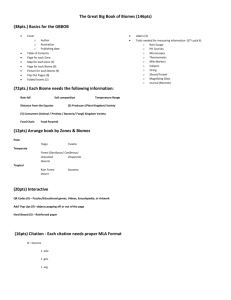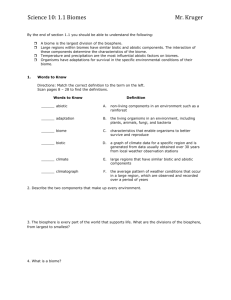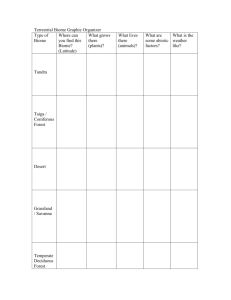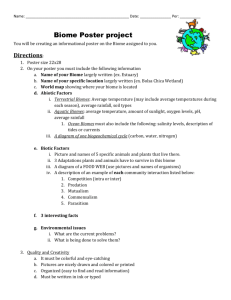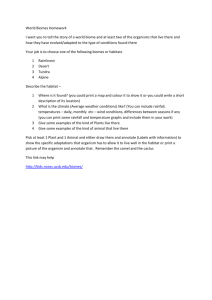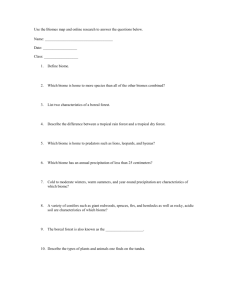biome review answer key
advertisement
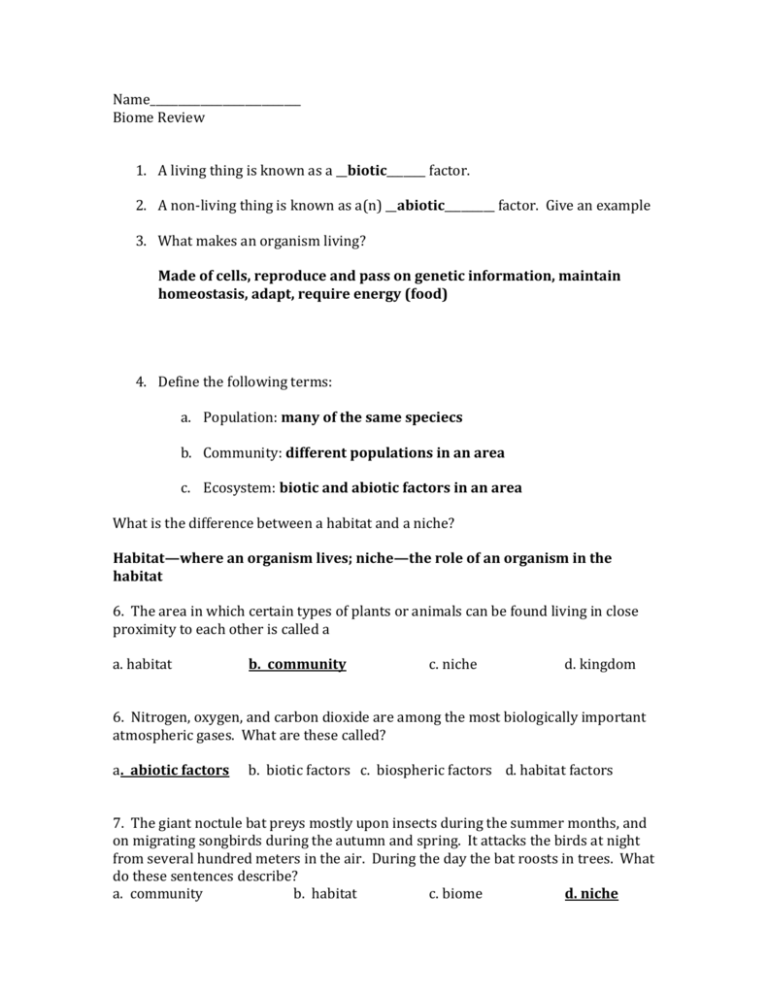
Name___________________________ Biome Review 1. A living thing is known as a __biotic_______ factor. 2. A non-living thing is known as a(n) __abiotic_________ factor. Give an example 3. What makes an organism living? Made of cells, reproduce and pass on genetic information, maintain homeostasis, adapt, require energy (food) 4. Define the following terms: a. Population: many of the same speciecs b. Community: different populations in an area c. Ecosystem: biotic and abiotic factors in an area What is the difference between a habitat and a niche? Habitat—where an organism lives; niche—the role of an organism in the habitat 6. The area in which certain types of plants or animals can be found living in close proximity to each other is called a a. habitat b. community c. niche d. kingdom 6. Nitrogen, oxygen, and carbon dioxide are among the most biologically important atmospheric gases. What are these called? a. abiotic factors b. biotic factors c. biospheric factors d. habitat factors 7. The giant noctule bat preys mostly upon insects during the summer months, and on migrating songbirds during the autumn and spring. It attacks the birds at night from several hundred meters in the air. During the day the bat roosts in trees. What do these sentences describe? a. community b. habitat c. biome d. niche 8. Define the following terms and give an example: a. Producer (Autotroph) create their own energy such as plants b. Consumer (Heterotroph) have to make their energy such as animals c. Herbivore: plant eating organism d. Omnivore: consumes plant and animals e. Decomposer: breaks down dead, decaying organisms 9. What is the difference between a food chain and a food web? Which one is more stable and why? Draw your own food web and discuss what would happen if you add and remove organisms. Food chain shows the transfer of energy in a “single line” such as Grassrabbitfox hawk Not as stable as a food web Food web is many connected food chains. More stable than a food chain. Not as much impact if you remove an organism. 10. Put the following organisms into food chain. Grass->Rabbit->Fox->Hawk Other terms about Biomes that you need to know: Coniferous tree: cone-bearing tree such as an evergreen; most found in the taiga Fauna: the animals that live in a biome Flora: the plants that live in a biome Permafrost: permanently frozen soil found in the tundra Canopy: top layer of the tress in the rainforest (think of canopy bed) Biome: an area characterized by its climate, plant life and animal life Precipitation: rain, snow, sleet, hail, etc. Ecology: study of how biotic and abiotic factors interact in an area Deciduous tree: trees in that lose their leaves in the fall, are dormant in the winter and re-bloom in the spring (most trees in our area such as oak, maple, etc.) Types of Biomes: Use your notes to find the information about climate, plant life, animal life, and other characteristics about each biome. Tropical Rainforest: closest to the equator, most rainfall, abundant plant and animal life, humid Desert: very dry, hot during the day, cooler at night, scarce plant life, but do have cacti that can store water when it does rain; many animals are nocturnal (hunt at night) because of heat Temperate Deciduous Forest: where we live, 4 seasons, variety of plant life such as oak and maple trees (lose their leaves in fall), variety of animal life such as deer, squirrels, chipmunks, forms of precipitation include rain, snow, sleet Tundra: coldest biome, permafrost, very dry climate, not much variety of plant life—most are low growing, animals include polar bears, penguins Taiga: coniferous forest, animals such as brown bears, colder climate, snow Grassland: not as many trees, grazing animals, enough precipitation to support the growth of the grasses, middle parts of the United States Climate/Biomes 1. What is the difference between weather and climate? Weather is the day to day temperature and precipitation, climate is the average over a long period of time. 2. There will be a few questions on biomes from your biome chart: a. Which biome has the least precipitation? (amount of rainfall or snow) desert b. Which biome is found as a belt around the equator? Hint, high humidity and rainfall Tropical rainforest c. Which biome has a permanently frozen ground, 24 hours of daylight in the summer, and is home to polar bears and penguins? tundra d. Which biome do we live in? Temperate deciduous forest e. What abiotic factors determine the climate of a biome? (Remember that abiotic means nonliving) How close to equator (latitude and longitude),distance from water, mountains,
